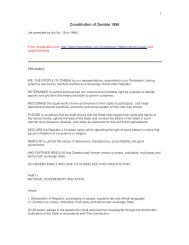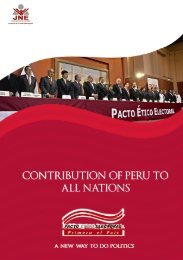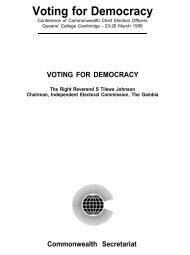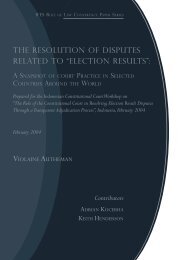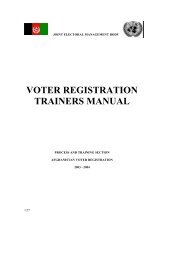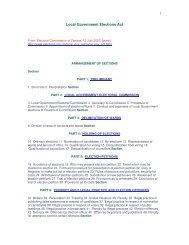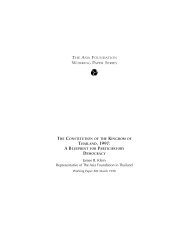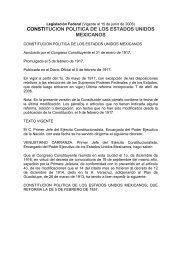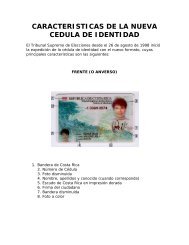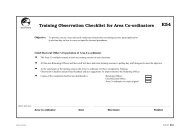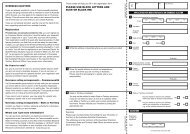Electoral systems and the protection and participation of minorities
Electoral systems and the protection and participation of minorities
Electoral systems and the protection and participation of minorities
You also want an ePaper? Increase the reach of your titles
YUMPU automatically turns print PDFs into web optimized ePapers that Google loves.
greater than 10 per cent <strong>of</strong> <strong>the</strong> population <strong>the</strong> over/underdivision is 8/9.When it comes to representation by electoral system<strong>the</strong> 20 PR cases (<strong>of</strong> List, MMP <strong>and</strong> STV) perform best,although only under MMP (New Zeal<strong>and</strong> <strong>and</strong> Germany)are <strong>minorities</strong>, on average, over-represented (<strong>and</strong> this isdriven by New Zeal<strong>and</strong>). However, if one removes Estonia<strong>and</strong> Latvia from <strong>the</strong> List PR group, <strong>the</strong> averageover-representation <strong>of</strong> a minority moves to a system high<strong>of</strong> 0.9. This gives us a better picture <strong>of</strong> <strong>the</strong> general trendunder List PR, because those two cases so dramaticallyunder-represent Russian-speakers that <strong>the</strong>y skew <strong>the</strong> entireresults. This is more due to lack <strong>of</strong> voting rights for Russiansin <strong>the</strong> Baltic states than <strong>the</strong> effect <strong>of</strong> List PR. Theworst system on average for minority groups is SNTV,but again this is driven by <strong>the</strong> single case <strong>of</strong> Afghanistanin 2005.A more nuanced analysis <strong>of</strong> Table 1 finds that: (1)white people are consistently over-represented when <strong>the</strong>yare a small minority in a former colonial possession(Namibia, Polynesia, South Africa, Zambia, Zimbabwe).(2) Small but economically powerful communities <strong>of</strong>South Asians are <strong>of</strong>ten slightly over-represented in Africa(although not in Fiji <strong>and</strong> <strong>the</strong> UK). (3) When consociationalregimes are based on List PR elections (as <strong>the</strong>yusually are), significant minority players can be over-represented(e.g. French-speakers in Belgium <strong>and</strong>Switzerl<strong>and</strong>; whites, coloureds <strong>and</strong> Indians in SouthAfrica).Regionally, minority groups are more likely to be overrepresentedin Western Europe <strong>and</strong> North America (14groups were over-represented, 12 under-represented) thanin <strong>the</strong> Asia-Pacific region (4/8) or Eastern/Central Europe(4/7). While <strong>the</strong> eight <strong>minorities</strong> in African states in Table1 (five countries) are all over-represented to some degree.Some <strong>of</strong> <strong>the</strong> most vibrant minority representation can befound in <strong>the</strong> large district closed List PR <strong>systems</strong> <strong>of</strong> <strong>the</strong>Ne<strong>the</strong>rl<strong>and</strong>s <strong>and</strong> South Africa, where members <strong>of</strong> <strong>minorities</strong>sit on <strong>the</strong> government <strong>and</strong> opposition benches, in big<strong>and</strong> small parties. The 15 minority MPs in <strong>the</strong> Dutchparliament in 2006 were born in Curaçao (1), Suriname(4), Morocco (3), Iran (1), Turkey (5) <strong>and</strong> Portugal (1),<strong>and</strong> <strong>the</strong>y are distributed between six parties: CDA (4), GL(4), PVDA (3), VVD (2), D66 (1), LPF (1). In SouthAfrica’s first two democratic elections, minority white,coloured <strong>and</strong> Indian MPs were included in both <strong>the</strong> governingAfrican National Congress (ANC) <strong>and</strong> oppositionparties. In 1994 <strong>and</strong> 1999 <strong>the</strong> ANC was catapulted tovictory on <strong>the</strong> back <strong>of</strong> a vote which was overwhelminglyrooted in <strong>the</strong> black South African community, but inboth parliaments white MPs constituted 10–15 per cent<strong>of</strong> <strong>the</strong> ANC’s caucus. Only half <strong>of</strong> <strong>the</strong> Zulu TraditionalInkatha Freedom Party MPs were Zulu, <strong>the</strong> o<strong>the</strong>rs beingwhite <strong>and</strong> Indian South Africans.Even though <strong>the</strong>y use an FPTP system, Canada displaysa significant number (21) <strong>of</strong> minority MPs (notincluding Francophone Canadians) who cut across partyboundaries: <strong>the</strong>re are 12 Liberals, 6 Conservatives, 2 BlocQuébecois <strong>and</strong> 1 NDP.In a natural experiment in Britain <strong>and</strong> Irel<strong>and</strong>, <strong>the</strong>MMP system does not perform quite as well as <strong>the</strong> NewZeal<strong>and</strong> case might suggest. Currently <strong>the</strong> United Kingdomoperates MMP elections for <strong>the</strong> Scottish <strong>and</strong> Welsh<strong>and</strong> London Assemblies, List PR for elections to <strong>the</strong>European Parliament <strong>and</strong> FPTP for <strong>the</strong> House <strong>of</strong> Commons.Nor<strong>the</strong>rn Irel<strong>and</strong> uses STV to elect its Assembly<strong>and</strong> List PR for Euro elections. As Table 4 shows, <strong>the</strong>reare five Asian MEPs (6.4 per cent) elected by List PR,which compares well to <strong>the</strong>ir 2.9 per cent populationshare. There is a record high <strong>of</strong> 10 (1.5 per cent) AsianMPs in <strong>the</strong> House <strong>of</strong> Commons elected by FPTP, butonly a single British-Asian Assembly member in <strong>the</strong> Scottish,Welsh <strong>and</strong> London Assemblies combined. Incontrast, <strong>the</strong>re are only five (0.8 per cent) Afro-CaribbeanMPs at Westminster, a single London Assembly member,<strong>and</strong> none in Scotl<strong>and</strong>, Wales or Nor<strong>the</strong>rn Irel<strong>and</strong>. TheEuropean Afro-Caribbean <strong>and</strong> Asian MPs demonstrateparty balance – two Labour, two Conservative, one LiberalDemocrat; in <strong>the</strong> House <strong>of</strong> Commons thirteenAfro-Caribbean <strong>and</strong> Asian Labour MPs are joined by twoTories, while both Afro-Caribbean <strong>and</strong> Asian LondonAssembly members are Labour.Table 3: Ethnic diversity <strong>of</strong> South African National Assembly 1994–9AfricanWhiteColouredIndian1994 numbers1994 %1999 numbers1999 %% population20852232587513032104261329742109338225314 ELECTORAL SYSTEMS AND THE PROTECTION AND PARTICIPATION OF MINORITIES



